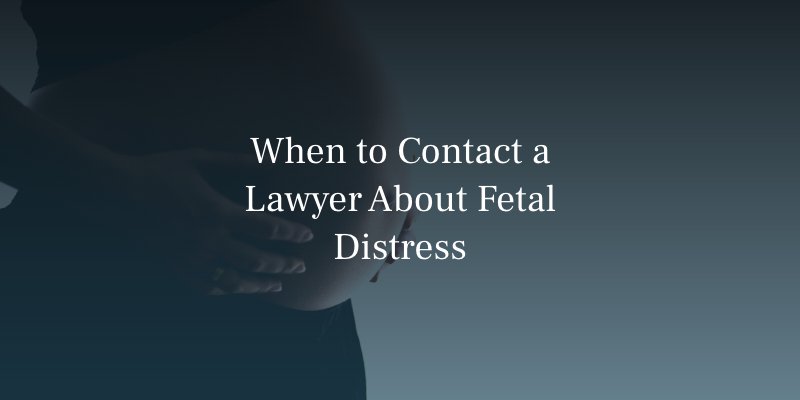Pregnancy is often described as a journey – but sometimes that journey takes an unexpected and dangerous turn. One of the most critical warning signs that something is wrong is fetal distress. This term refers to any indication that a baby may be struggling in the womb, often due to a lack of oxygen.
Recognizing these red flags early and responding quickly can make the difference between a healthy delivery and a tragic outcome.
If you suspect your baby showed signs of fetal distress that weren’t properly addressed, contact a Hampton & King Houston, Texas birth injury lawyer at (713) 352-7214.
Protect your family’s future by scheduling a free consultation today.

What is Fetal Distress?
Fetal distress is a medical term that means a baby (fetus) in the womb is not doing well. It means they’re experiencing some sort of problem or stress during pregnancy or delivery.
When a baby is in the womb, it relies on the mother’s placenta and umbilical cord to get oxygen and nutrients. If something affects the baby’s oxygen supply, or if there’s a problem with the baby’s heart rate, it can lead to fetal distress; diagnosed, ideally, as soon as possible.
Another term doctors often use in place of fetal distress is “nonreassuring fetal status”.
Signs That the Baby is in Distress: Third Trimester
You should always be on the lookout for signs your baby is in distress in the womb. But be especially watchful during the third trimester. It’s the time in pregnancy when fetal distress is most likely to happen.
This is one reason why prenatal monitoring gets more frequent as you approach your due date. Certain dangers become increasingly likely, like umbilical cord compression, which can compromise blood flow and oxygen delivery to the fetus, leading to fetal distress.
What are the Signs of Fetal Distress?
Common signs that the baby is in distress in the third trimester include:
- Quick weight gain
- Vaginal bleeding
- Reported decreased fetal movements; when the baby is moving less or not at all (ask your doctor how to measure kick counts)
- Abdominal pain
- Preterm contractions/cramps
- Abnormal fetal heart rate
- Abnormal amniotic fluid levels
- Meconium in the amniotic fluid
- Excessive fetal growth
- Fetal growth restriction
- Abnormal results of biophysical profile (BPP) (fetal breathing, amniotic fluid volume, fetal movement, and fetal tone)
You may notice that some of the signs above can only be measured with a doctor’s help. At each prenatal appointment, your doctor should use ultrasounds and other tests to make sure there are no signs your baby is in distress in the womb.
Risk Factors for Fetal Distress
Certain conditions make fetal distress more likely. If your pregnancy involves any of these, your care team should take additional precautions:
- Maternal diabetes
- High blood pressure or preeclampsia
- Multiple gestation (twins, triplets, etc.)
- Placenta previa or placental abruption
- Infections during pregnancy
- Advanced maternal age
- Previous cesarean delivery or uterine surgery
Monitoring high-risk pregnancies closely is part of a doctor’s duty. Failure to do so can lead to missed warning signs.
Causes of Fetal Distress in the Third Trimester and Delivery
Some common causes of fetal distress include:
- Problems with the placenta. The placenta might not be working correctly, which can limit the baby’s oxygen and food supply.
- Fetal anemia. The level of red blood cells is lower than it should be.
- Oxygen deprivation. When the baby doesn’t receive enough oxygen before or during birth, it can lead to fetal distress.
- Umbilical cord issues. If the umbilical cord gets compressed or twisted (sometimes into a true knot), it can reduce blood flow and oxygen to the baby.
- Maternal health issues. Certain health conditions in the mother, like high blood pressure or diabetes, can cause fetal distress.
- Infections. Infections during pregnancy can also cause fetal distress. Examples include cytomegalovirus (CMV), toxoplasmosis, and rubella.
- Low amniotic fluid. A condition known as oligohydramnios, low amniotic fluid surrounding the baby can restrict fetal movement and growth, and cause fetal distress.
- Complications during labor. Difficulties during labor can put stress on the baby.
- Preeclampsia: Characterized by high blood pressure in the mother, preeclampsia can reduce blood flow to the fetus, causing distress.
This isn’t an exhaustive list of everything that can cause fetal distress. Sometimes the cause is unknown.
In rare cases, a doctor’s actions can be the cause. One example of this is when a doctor uses forceps or a vacuum to assist delivery, but does so improperly.

Complications from Fetal Distress
Fetal distress signs often indicate the baby isn’t getting enough oxygen. When babies fail to receive immediate care when in distress, a lack of oxygen can cause birth injuries.
Birth injuries stemming from fetal distress include:
Hypoxic-Ischemic Encephalopathy (HIE)
HIE is a type of brain damage that occurs when the baby’s brain doesn’t get enough oxygen and blood during labor or delivery. This condition can range in severity, but even mild cases may require lifelong therapy.
More severe HIE cases may result in permanent disabilities, including motor and cognitive impairments, or even death.
Cerebral Palsy (CP)
Often caused by brain damage from oxygen deprivation, cerebral palsy affects muscle tone, movement, and posture. Children with CP may have difficulty walking, speaking, or performing everyday tasks. Some require assistive devices or full-time care, depending on the severity.
Behavioral and Emotional Disorders
Oxygen deprivation at birth can interfere with the development of emotional regulation and behavioral control. Children may struggle with anxiety, ADHD, mood disorders, or difficulty forming social bonds. These challenges often require ongoing psychological or educational support.
Impaired Hearing or Eyesight
In some cases, fetal distress can impact sensory development, leading to partial or complete hearing or vision loss. These impairments can further complicate communication, learning, and social development for the child.
Epilepsy and Seizures
Brain damage related to HIE or other oxygen-related injuries can increase the risk of seizure disorders, including epilepsy. Some children may require daily medication to control seizures, while others experience frequent or unpredictable episodes that interfere with daily life.
Intellectual and developmental disabilities (IDD)
Children who suffer birth injuries due to fetal distress may face cognitive delays, learning disabilities, or difficulties with language and memory. These disabilities can affect school performance, social development, and independence in adulthood.
These outcomes don’t just affect the child—they impact the entire family. Lifelong care, therapies, special education, and medical expenses can place a tremendous emotional and financial burden on parents. And when these injuries result from preventable medical mistakes, families deserve accountability and support.
If your child was diagnosed with any of these conditions and you suspect medical negligence played a role, reach out to Hampton & King at (713) 352-7214 or complete our simple online form to schedule your free consultation.
Treatment for Fetal Distress
When doctors notice signs of fetal distress, they should take quick action to help the baby. Depending on the severity and cause of the distress, they may try different interventions, such as:
- Changing the mother’s position.
- Providing oxygen to the mother.
- Performing an emergency C-section to deliver the baby safely (for more serious complications).
- Giving an amnioinfusion if the amniotic fluid is low.
Frequently Asked Questions About Fetal Distress
Can fetal distress occur before labor starts?
Yes. Fetal distress can happen during the later stages of pregnancy, not just during labor. Reduced fetal movement, abnormal test results, or low amniotic fluid levels can signal problems before labor begins.
How is fetal distress treated?
Doctors may give the mother oxygen, IV fluids, or medications to stabilize the baby. In urgent cases, an emergency C-section is often the fastest and safest way to prevent complications.
Can fetal distress cause long-term disabilities?
Yes. If not treated quickly, fetal distress can lead to brain damage, developmental delays, cerebral palsy, or other long-term conditions caused by lack of oxygen at birth.
How do doctors monitor for fetal distress during labor?
Doctors use continuous electronic fetal monitoring (EFM) to track the baby’s heart rate. Abnormal patterns, like bradycardia or late decelerations, can indicate distress.
Is fetal distress always preventable?
Not always – but in many cases, proper monitoring and timely intervention can prevent injury. When doctors miss or ignore warning signs, it may amount to medical negligence.
What are the legal options if my baby was harmed by fetal distress?
You may be able to file a medical malpractice claim. A birth injury lawyer can investigate your case and help you pursue compensation for your child’s medical needs and future care.
How soon after birth can I file a fetal distress malpractice claim?
You can file a malpractice claim as soon as you become aware of the malpractice. There may be a limit on how long after birth you can file, though.
The statute of limitations for this type of case in Texas is typically 2 years; however, this is different for health care liability claims involving children under the age of 12. In these cases, you have until their 14th birthday to file a claim.
In New Mexico, you can file up to the child’s 9th birthday, provided the claim involves a child under 6.
Can I sue if my baby was stillborn due to fetal distress?
Possibly. If medical professionals failed to act on signs of distress and that failure caused the stillbirth, you may have a wrongful death or malpractice claim. An attorney can advise you based on your specific situation.
How much compensation can I recover in a fetal distress lawsuit?
Compensation varies but may include coverage for medical bills, therapy, special education, assistive equipment, and pain and suffering. In severe cases, settlements can reach hundreds of thousands or even millions of dollars.
Legal Help for Harm Caused by Untreated Fetal Distress
Ever heard the phrase, “trust your gut”? That’s certainly applicable in pregnancy. If you feel something is wrong during your pregnancy, trust your instincts. The baby is in your womb, and no one else’s, after all.
Unfortunately, we’ve seen cases where doctors ignored a woman’s gut feeling that her fetus was in distress. They failed to check for distress and thus failed to treat it.
Failing to treat fetal distress can lead to complications and birth injuries like the following:
- Hypoxic-ischemic encephalopathy (HIE)
- Cerebral palsy
- Seizures
- Hearing impairments
- Vision problems
- Intellectual disabilities
- Behavioral disorders

When to Contact a Lawyer About Fetal Distress
If your child suffered a birth injury and you believe fetal distress played a role, don’t wait to seek legal guidance. Medical providers are expected to recognize and respond to warning signs during pregnancy and delivery. When they fail to do so, the consequences can be life-altering – and in some cases, preventable.
You may have grounds for a malpractice claim if any of the following occurred:
- A delayed emergency C-section, even though fetal distress signs were present
- Inadequate or missing fetal monitoring during labor and delivery
- Misinterpretation of fetal heart rate patterns, leading to a failure to act
- Unexplained labor complications that weren’t investigated or properly addressed
A birth injury attorney can review your medical records, consult with medical professionals, and determine whether a healthcare provider failed to uphold the standard of care. If negligence caused your baby’s injury, you may be entitled to financial compensation for ongoing medical expenses, therapy, and more.
If you suspect medical negligence contributed to your child’s birth injury, contact Hampton & King in Houston at (713) 489-0993 or complete our simple online form to schedule your free consultation.




